
|
Marsden group's comet. Three apparitions of this comet was confirmed in 1999, 2004 and 2010. It will approach to Sun down to 0.044 a.u. on Feb. 28. After the perihelion passage, it may be observed on the ground from March to April.
Date(TT) R.A. (2000) Decl. Delta r Elong. m1 Best Time(A, h)
Feb. 20 22 8.40 -17 49.1 1.370 0.406 6 18.8 4:08 (302,-12)
Feb. 27 22 51.67 -9 32.9 1.081 0.107 3 9.6 20:07 ( 68,-15)
|
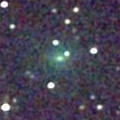
|
Brightened rapidly. Now it is very bright as 12.6 mag (Dec. 25, Ken-ichi Kadota). It will approach to Earth down to 0.46 a.u. in April, and it is expected to brighten up to 9 mag and to be observable in excellent condition. It becomes unobservable temporarily from January to February.
Date(TT) R.A. (2000) Decl. Delta r Elong. m1 Best Time(A, h)
Feb. 20 20 46.77 -13 6.4 1.900 1.042 21 11.1 4:08 (286, 0)
Feb. 27 20 41.52 -11 59.6 1.772 1.030 29 10.9 4:17 (280, 7)
|

|
Now it is bright as 10.5 mag (Feb. 6, Marco Goiato). In the Northern Hemisphere, it stays observable in excellent condition after this. In the Southern Heimsphere, it will be getting lower rapidly after this, and it will be unobservable in mid March.
Date(TT) R.A. (2000) Decl. Delta r Elong. m1 Best Time(A, h)
Feb. 20 5 49.66 26 44.2 0.736 1.471 116 11.5 20:17 (172, 27)
Feb. 27 5 27.99 34 22.2 0.906 1.502 104 12.1 20:07 (165, 18)
|
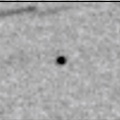
|
It will brighten up to 11.5 mag in spring. However, the condition is very bad in this apparition. It will appear in the morning low sky in March in the Southern Hemisphere, or in June in the Northern Hemisphere.
Date(TT) R.A. (2000) Decl. Delta r Elong. m1 Best Time(A, h)
Feb. 20 20 35.69 -17 36.6 2.294 1.453 24 12.1 4:08 (288, 5)
Feb. 27 20 59.76 -16 41.3 2.264 1.438 25 11.9 4:17 (286, 6)
|

|
Now it is bright as 12.9 mag (Feb. 9, Chris Wyatt). It stays 12 mag until March. In the Southern Hemisphere, it stays observable in good condition after this. In the Northern Hemisphere, it will never be observable after this.
Date(TT) R.A. (2000) Decl. Delta r Elong. m1 Best Time(A, h)
Feb. 20 16 12.91 -83 41.4 1.934 1.998 79 12.0 4:08 (356, 40)
Feb. 27 20 9.40 -88 21.7 1.965 2.046 80 12.1 4:17 (358, 35)
|

|
It brightened up to 5.6 mag in early December (Dec. 9, Marco Goiato). In mid December, it was visible at about 3 mag in the SOHO spacecraft images (Dec. 18, Hirohisa Sato). Now it is not observable. It will appear in the morning sky again in April. But then it will be fainter than 15 mag.
Date(TT) R.A. (2000) Decl. Delta r Elong. m1 Best Time(A, h)
Feb. 20 22 1.31 0 6.6 2.509 1.553 11 12.9 4:08 (287,-23)
Feb. 27 22 16.76 1 44.1 2.627 1.669 11 13.3 4:17 (282,-20)
|
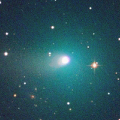
|
Brightened rapidly, and it brightened up to 9.7 mag in November (Nov. 15, Chris Wyatt). Now it is fading. But it is bright as 12.0 mag still now (Feb. 9, Chris Wyatt). In the Northern Hemisphere, it stays observable in good condition for a long time. In the Southern Hemisphere, it locates extremely low after this.
Date(TT) R.A. (2000) Decl. Delta r Elong. m1 Best Time(A, h)
Feb. 20 3 40.32 39 35.5 1.371 1.701 90 13.0 20:17 (151, 7)
Feb. 27 4 2.32 40 14.4 1.468 1.747 88 13.4 20:07 (152, 7)
|
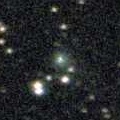
|
Now it is 12.4 mag (Feb. 8, Toshihiko Ikemura, Hirohisa Sato). It will brighten up to 10 mag in winter in 2022. In the Northern Hemisphere, it stays observable in good condition for a long time. In the Southern Hemisphere, it is not observable until November.
Date(TT) R.A. (2000) Decl. Delta r Elong. m1 Best Time(A, h)
Feb. 20 1 12.66 52 28.4 4.747 4.577 74 13.1 20:17 (141,-20)
Feb. 27 1 23.59 52 7.2 4.783 4.540 69 13.1 20:07 (140,-20)
|
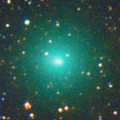
|
It brightened up to 8.2 mag in autumn (Oct. 13, Chris Wyatt). Now it is fading. It has already faded down to 13.0 mag (Feb. 14, Sandor Szabo). In the Southern Hemisphere, it is already unobservable. In the Northern Hemisphere, it will be unobservable in late February.
Date(TT) R.A. (2000) Decl. Delta r Elong. m1 Best Time(A, h)
Feb. 20 0 13.99 -0 39.2 2.794 2.021 31 13.5 20:17 ( 89, -1)
Feb. 27 0 28.55 1 2.9 2.880 2.067 28 13.8 20:07 ( 90, -2)
|
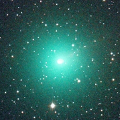
|
It brightened up to 7.3 mag in November (Nov. 7, Marco Goiato). Now it is fading. It has already faded down to 14.0 mag (Feb. 7, Toshihiko Ikemura, Hirohisa Sato). In the Northern Hemisphere, it stays observable in excellent condition for a long time. In the Southern Hemisphere, it stays locating extremely low after this.
Date(TT) R.A. (2000) Decl. Delta r Elong. m1 Best Time(A, h)
Feb. 20 5 59.73 48 8.1 1.452 2.082 115 13.6 20:17 (177, 7)
Feb. 27 6 10.75 47 41.9 1.585 2.154 111 14.0 20:07 (176, 7)
|
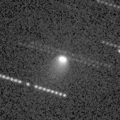
|
Brightening very rapidly. Now it is very bright as 12.5 mag (Feb. 8, Michael Jager). Now it is approaching to Earth down to 0.4 a.u. In the Northern Hemisphere, it stays observable in excellent condition. It will be observable in good condition after this also in the Southern Hemisphere.
Date(TT) R.A. (2000) Decl. Delta r Elong. m1 Best Time(A, h)
Feb. 20 5 5.07 35 47.0 0.495 1.228 106 13.6 20:17 (163, 18)
Feb. 27 4 36.90 19 19.6 0.630 1.193 92 13.8 20:07 (147, 29)
|
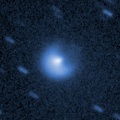
|
Now it is 13.9 mag (Feb. 9, Toshihiko Ikemura, Hirohisa Sato). In the Southern Hemisphere, it will be unobservable in late February.
Date(TT) R.A. (2000) Decl. Delta r Elong. m1 Best Time(A, h)
Feb. 20 2 28.12 23 59.9 6.099 5.859 71 13.7 20:17 (129, 10)
Feb. 27 2 31.98 24 7.5 6.205 5.861 65 13.7 20:07 (126, 7)
|
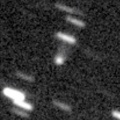
|
It will brighten up to 13 mag from spring to summer. In the Southern Hemisphere, it stays observable in good condition for a long time. In the Northern Hemisphere, it is not observable until July in 2022.
Date(TT) R.A. (2000) Decl. Delta r Elong. m1 Best Time(A, h)
Feb. 20 17 45.18 -57 1.5 4.015 3.764 68 13.8 4:08 (319, 48)
Feb. 27 17 58.59 -58 37.5 3.921 3.746 72 13.7 4:17 (322, 50)
|
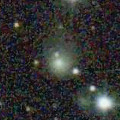
|
Now it is 14.2 mag (Feb. 8, Toshihiko Ikemura, Hirohisa Sato). It is expected to be observable at 5-6 mag for a long time from 2022 to 2023. In the Northern Hemisphere, it is not observable at the high light from 2022 summer to 2023 summer. In the Southern Hemisphere, it is not observable now. But it will be observable in good condition at the high light.
Date(TT) R.A. (2000) Decl. Delta r Elong. m1 Best Time(A, h)
Feb. 20 18 19.59 36 16.5 7.281 7.046 72 13.8 4:08 (226, -2)
Feb. 27 18 22.22 36 43.0 7.177 6.991 75 13.7 4:17 (221, 2)
|
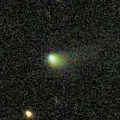
|
Now it is 15.5 mag (Jan. 19, Slooh.com Chile Observatory, La Dehesa). It stays 13-14 mag from 2020 to 2021. It will be observable in good condition after this in the Southern Hemisphere. It locates somewhat low in the Northern Hemisphere.
Date(TT) R.A. (2000) Decl. Delta r Elong. m1 Best Time(A, h)
Feb. 20 18 8.02 -22 22.0 3.237 2.864 59 14.1 4:08 (273, 37)
Feb. 27 18 18.36 -22 41.2 3.155 2.864 64 14.1 4:17 (270, 42)
|
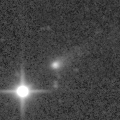
|
Now it is 14.2 mag (Feb. 9, Toshihiko Ikemura, Hirohisa Sato). It is expected to brighten up to 12.5 mag from spring to summer, and it stays observable in good condition for a long time.
Date(TT) R.A. (2000) Decl. Delta r Elong. m1 Best Time(A, h)
Feb. 20 14 0.49 29 52.2 1.949 2.634 124 14.4 4:01 (180, 25)
Feb. 27 14 4.08 30 47.7 1.860 2.586 127 14.2 3:37 (180, 24)
|

|
First return of a new periodic comet which brightened up to 13 mag in 2009. It brightened up to 11.7 mag in January (Jan. 10, Marco Goiato). Now it is fading. It has already faded down to 13.7 mag (Feb. 7, Toshihiko Ikemura, Hirohisa Sato). It stays observable in good condition while the comet will be fading after this.
Date(TT) R.A. (2000) Decl. Delta r Elong. m1 Best Time(A, h)
Feb. 20 6 28.71 24 36.3 0.631 1.447 125 14.2 20:28 (180, 30)
Feb. 27 6 46.94 26 7.3 0.695 1.482 122 14.6 20:19 (180, 29)
|
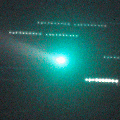
|
It brightened very rapidly in early December, and it brightened up to 10.0 mag in January (Jan. 7, Michael Jager). Now it is fading. It has already faded down to 13.3 mag (Feb. 9, Chris Wyatt). Two more components, H and I, are also observed. It stays observable for a long time in this apparition.
Date(TT) R.A. (2000) Decl. Delta r Elong. m1 Best Time(A, h)
Feb. 20 4 32.02 1 20.1 0.747 1.289 94 14.2 20:17 (140, 46)
Feb. 27 5 3.13 2 33.5 0.837 1.363 96 15.1 20:07 (146, 47)
|
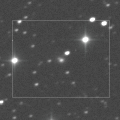
|
Now it is 14.4 mag (Jan. 20, iTelescope Observatory, Siding Spring). It will brighten up to 13.5 mag in spring. In the Southern Hemisphere, it stays observable in good condition for a long time. In the Northern Hemisphere, it will be getting higher and becoming observable slowly.
Date(TT) R.A. (2000) Decl. Delta r Elong. m1 Best Time(A, h)
Feb. 20 17 50.34 -40 18.9 3.706 3.398 64 14.7 4:08 (294, 46)
Feb. 27 17 48.21 -40 6.4 3.570 3.389 71 14.6 4:17 (292, 53)
|
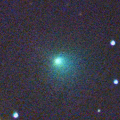
|
New periodic comet discovered in 2016. It had been predicted to return in 2024. But actually, it returned much earlier than predicted. It brightened up to 11 mag in January (Jan. 16, Giuseppe Pappa). Now it is fading. In the Southern Hemisphere, it stays observable in excellent condition after this. In the Northern Hemisphere, it will never be observable after this.
Date(TT) R.A. (2000) Decl. Delta r Elong. m1 Best Time(A, h)
Feb. 20 20 3.03 -51 23.8 0.576 0.742 48 14.6 4:08 (315, 27)
Feb. 27 19 36.76 -52 21.8 0.615 0.839 57 16.0 4:17 (313, 37)
|

|
Now it is 14.2 mag and visible visually (Jan. 25, Chris Wyatt). It is expected to brighten up to 11.5 mag in 2022. It is observable in excellent condition in the Southern Hemisphere. In the Northern Hemisphere, it is observable from autumn to winter, but it locating extremely low.
Date(TT) R.A. (2000) Decl. Delta r Elong. m1 Best Time(A, h)
Feb. 20 8 4.38 -38 59.0 5.139 5.720 121 14.7 22:02 ( 0, 86)
Feb. 27 8 2.12 -38 14.7 5.116 5.684 120 14.6 21:32 ( 0, 87)
|
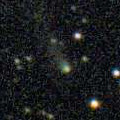
|
Now it is 15.9 mag (Nov. 10, Toshihiko Ikemura, Hirohisa Sato). It will stay at 14 mag for a long time from 2021 to 2022. In the Northern Hemisphere, it stays observable in good condition while brightening gradually. In the Southern Hemisphere, it will appear in the morning sky soon. Then it will be observable in good condition.
Date(TT) R.A. (2000) Decl. Delta r Elong. m1 Best Time(A, h)
Feb. 20 18 20.55 2 44.3 5.798 5.364 59 15.1 4:08 (252, 20)
Feb. 27 18 22.05 2 33.4 5.684 5.345 65 15.0 4:17 (246, 27)
|

|
It had been observed as 8-9 mag for a long time in 2020. Now it is fading. It has already faded down to 16.6 mag (Jan. 23, Slooh.com Chile Observatory, La Dehesa). It will be observable in good condition after this in the Southern Hemisphere. It locates extremely low after this in the Northern Hemisphere.
Date(TT) R.A. (2000) Decl. Delta r Elong. m1 Best Time(A, h)
Feb. 20 17 36.28 -33 0.3 4.141 3.858 66 15.0 4:08 (283, 47)
Feb. 27 17 40.13 -33 57.3 4.101 3.924 72 15.1 4:17 (281, 54)
|

|
Now it is 15.8 mag (Jan. 16, Slooh.com Canary Islands Observatory). It is not observable until June.
Date(TT) R.A. (2000) Decl. Delta r Elong. m1 Best Time(A, h)
Feb. 20 22 52.61 -1 23.3 3.027 2.080 13 15.0 20:17 ( 76,-17)
Feb. 27 23 6.68 0 39.2 3.043 2.081 11 15.1 20:07 ( 78,-19)
|
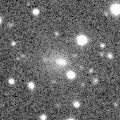
|
Brightened very rapidly. Now it is 15.0 mag (Feb. 4, Michael Jager). It stays observable at 15-16 mag in good condition for a while. It locates low in the Southern Hemisphere.
Date(TT) R.A. (2000) Decl. Delta r Elong. m1 Best Time(A, h)
Feb. 20 3 57.24 27 42.9 1.614 1.917 91 15.1 20:17 (147, 19)
Feb. 27 4 12.58 27 56.1 1.696 1.934 88 15.1 20:07 (147, 19)
|

|
Now it is 15.8 mag (Jan. 14, Slooh.com Chile Observatory, La Dehesa). It stays 14-15 mag until the end of 2021. In the Southern Hemisphere, it stays observable in good condition for a long time, although it becomes extremely low temporarily from January to February. In the Northern Hemisphere, it is not observable until June.
Date(TT) R.A. (2000) Decl. Delta r Elong. m1 Best Time(A, h)
Feb. 20 22 3.52 -47 3.6 5.094 4.334 36 15.2 4:08 (323, 9)
Feb. 27 22 13.23 -45 53.5 5.070 4.331 37 15.2 4:17 (319, 11)
|
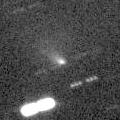
|
Now it is 16.0 mag (Feb. 8, Michael Jager). It stays 15-16 mag until spring. In the Northern Hemisphere, it stays observable in excellent condition. In the Southern Hemisphere, it stays extremely low until spring.
Date(TT) R.A. (2000) Decl. Delta r Elong. m1 Best Time(A, h)
Feb. 20 2 42.98 22 18.6 1.238 1.355 73 15.4 20:17 (130, 13)
Feb. 27 3 8.79 20 33.3 1.250 1.335 72 15.5 20:07 (130, 16)
|

|
First return of a new periodic comet which brightened up to 14-15 mag in 2006. Now it is 15.5 mag (Feb. 8, Toshihiko Ikemura, Hirohisa Sato). It will brighten up to 15-16 mag from February to March, and will be observable in good condition.
Date(TT) R.A. (2000) Decl. Delta r Elong. m1 Best Time(A, h)
Feb. 20 13 7.55 9 29.4 0.914 1.772 137 15.4 3:08 (180, 46)
Feb. 27 13 13.42 11 32.5 0.896 1.784 142 15.4 2:47 (180, 44)
|

|
Now it is 16.3 mag (Nov. 9, Toshihiko Ikemura, Hirohisa Sato). It will brighten up to 14.5 mag from spring to summer. In the Southern Hemisphere, it stays observable in excellent condition for a long time, although it becomes extremely low temporarily from January to February. In the Northern Hemisphere, it is not observable after this.
Date(TT) R.A. (2000) Decl. Delta r Elong. m1 Best Time(A, h)
Feb. 20 22 24.08 -39 26.4 3.551 2.724 28 15.5 20:17 ( 43, 3)
Feb. 27 22 33.65 -40 22.4 3.496 2.707 31 15.5 4:17 (317, 5)
|
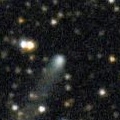
|
Now it is 15.5 mag (Feb. 9, Toshihiko Ikemura, Hirohisa Sato). It stays 15-16 mag until spring. In the Northern Hemisphere, it stays observable in good condition for a long time. In the Southern Hemisphere, it will be observable in the extremely low sky only in next spring.
Date(TT) R.A. (2000) Decl. Delta r Elong. m1 Best Time(A, h)
Feb. 20 19 16.05 30 10.4 5.333 4.902 59 15.5 4:08 (238, -7)
Feb. 27 19 18.37 31 43.0 5.301 4.925 62 15.6 4:17 (232, -3)
|
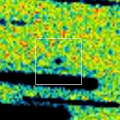
|
It will brighten up to 13 mag from spring to summer. In the Southern Hemisphere, it stays observable in good condition for a long time. In the Northern Hemisphere, it locates extremely low now, and it will be unobservable soon. Then it is not observable until September when it fades down to 15 mag.
Date(TT) R.A. (2000) Decl. Delta r Elong. m1 Best Time(A, h)
Feb. 20 19 21.57 -27 30.1 2.697 2.093 43 15.9 4:08 (288, 24)
Feb. 27 19 37.71 -29 9.0 2.568 2.033 47 15.6 4:17 (287, 29)
|

|
Now it is not observable. It will be observable in June. But it will fade down to 17 mag at that time.
Date(TT) R.A. (2000) Decl. Delta r Elong. m1 Best Time(A, h)
Feb. 20 21 55.11 -16 43.0 2.572 1.596 7 15.7 4:08 (299,-11)
Feb. 27 22 15.40 -14 12.1 2.559 1.586 8 15.7 4:17 (295,-10)
|
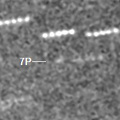
|
Now it is 18.1 mag, much fainter than predicted (Feb. 8, Toshihiko Ikemura, Hirohisa Sato). It will brighten up to 11 mag from May to August. In the Southern Hemisphere, it stays observable in excellent condition for a long time. In the Northern Hemisphere, it stays observable in good condition for a while. But it becomes extremely low after July.
Date(TT) R.A. (2000) Decl. Delta r Elong. m1 Best Time(A, h)
Feb. 20 15 58.72 9 48.3 1.262 1.675 95 16.1 4:08 (216, 38)
Feb. 27 16 16.99 9 46.5 1.172 1.624 97 15.8 4:17 (211, 40)
|
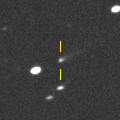
|
Now it is 15.5 mag (Feb. 9, Toshihiko Ikemura, Hirohisa Sato). It will brighten up to 13 mag in 2022. In 2021, it is observable at 15-16 mag in good condition.
Date(TT) R.A. (2000) Decl. Delta r Elong. m1 Best Time(A, h)
Feb. 20 13 45.40 -2 47.4 3.138 3.798 125 15.9 3:46 (180, 58)
Feb. 27 13 44.66 -2 37.6 3.041 3.782 132 15.8 3:18 (180, 58)
|

|
Now it is 14.9 mag (Feb. 9, Toshihiko Ikemura, Hirohisa Sato). In the Northern Hemisphere, it stays observable for a long time while it is getting fainter slowly. In the Southern Hemisphere, it will never be observable again.
Date(TT) R.A. (2000) Decl. Delta r Elong. m1 Best Time(A, h)
Feb. 20 16 35.96 64 49.8 5.080 5.302 97 15.8 4:08 (195,-14)
Feb. 27 16 32.30 65 43.9 5.113 5.349 98 15.9 4:17 (191,-13)
|

|
Now it is 16.5 mag (Feb. 5, Thomas Lehmann). It brightens up to 15 mag from spring to summer. In the Southern Hemisphere, it stays observable in good condition until June. In the Northern Hemisphere, it is observable in the low sky from March to May.
Date(TT) R.A. (2000) Decl. Delta r Elong. m1 Best Time(A, h)
Feb. 20 5 54.40 -55 18.7 2.349 2.622 94 16.0 20:17 ( 10, 69)
Feb. 27 5 55.86 -51 59.9 2.291 2.570 94 15.9 20:07 ( 21, 72)
|
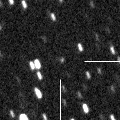
|
Now it is 16.4 mag (Jan. 17, D. Buczynski). In the Northern Hemisphere, it stays observable at 15 mag for a long time from spring to early 2022. In the Southern Hemisphere, it is not observable until the end of 2021.
Date(TT) R.A. (2000) Decl. Delta r Elong. m1 Best Time(A, h)
Feb. 20 20 8.55 50 1.9 3.756 3.488 66 16.5 4:08 (226,-26)
Feb. 27 20 12.15 51 44.6 3.700 3.454 68 16.4 4:17 (222,-22)
|
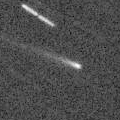
|
It brightened very rapidly up to 16.5 mag in January (Jan. 2, D. Buczynski). However, it is fading very rapidly in February. It has already faded down to 18.3 mag (Feb. 11, Toshihiko Ikemura, Hirohisa Sato). It is observable in excellent condition in the Northern Hemisphere. It locates somewhat low in the Southern Hemisphere.
Date(TT) R.A. (2000) Decl. Delta r Elong. m1 Best Time(A, h)
Feb. 20 3 12.22 20 39.7 1.281 1.475 79 16.5 20:17 (134, 19)
Feb. 27 3 34.51 22 34.7 1.335 1.494 78 16.6 20:07 (137, 18)
|
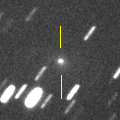
|
It brightened rapidly and became brighter than expected. Now it is 16.7 mag (Feb. 7, Toshihiko Ikemura, Hirohisa Sato). It is observable in good condition in the Northern Hemisphere. It locates somewhat low in the Southern Hemisphere.
Date(TT) R.A. (2000) Decl. Delta r Elong. m1 Best Time(A, h)
Feb. 20 3 58.04 21 57.4 1.680 1.959 90 16.5 20:17 (144, 24)
Feb. 27 4 12.23 21 32.8 1.764 1.974 86 16.6 20:07 (143, 24)
|

|
Now it is 17.0 mag (Feb. 6, Toshihiko Ikemura, Hirohisa Sato). It is expected to brighten up to 13 mag in 2022. In the Southern Hemisphere, it stays observable in good condition for a long time. In the Northern Hemisphere, it stays observable until June when it brightens up to 16 mag. But it will not be observable at the high light.
Date(TT) R.A. (2000) Decl. Delta r Elong. m1 Best Time(A, h)
Feb. 20 14 2.79 -18 28.4 4.895 5.404 116 16.8 4:04 (180, 74)
Feb. 27 13 58.69 -18 57.6 4.742 5.357 123 16.7 3:32 (180, 74)
|

|
Now it is 16.3 mag (Feb. 9, Toshihiko Ikemura, Hirohisa Sato). It is observable at 16.5 mag from spring in 2020 to summer in 2021.
Date(TT) R.A. (2000) Decl. Delta r Elong. m1 Best Time(A, h)
Feb. 20 17 52.22 -10 54.7 5.061 4.711 63 16.8 4:08 (259, 34)
Feb. 27 17 52.02 -11 17.9 4.954 4.721 70 16.7 4:17 (253, 41)
|
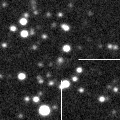
|
Now it is 16.6 mag (Nov. 9, Toshihiko Ikemura, Hirohisa Sato). It stays at 16-17 mag from 2020 to 2021. In the Northern Hemisphere, it stays observable in good condition for a long time. It is not observable in the Southern Hemisphere.
Date(TT) R.A. (2000) Decl. Delta r Elong. m1 Best Time(A, h)
Feb. 20 19 37.36 34 7.6 9.298 8.820 58 16.8 4:08 (237,-13)
Feb. 27 19 39.73 34 56.1 9.261 8.820 60 16.7 4:17 (233, -8)
|

|
Now it is 16.8 mag (Feb. 6, Toshihiko Ikemura, Hirohisa Sato). It stays observable at 16-17 mag from 2021 to 2022.
Date(TT) R.A. (2000) Decl. Delta r Elong. m1 Best Time(A, h)
Feb. 20 14 29.94 -24 43.9 4.628 5.022 107 16.8 4:08 (207, 79)
Feb. 27 14 29.35 -23 57.6 4.498 5.003 115 16.8 4:03 (180, 79)
|

|
Now it is 16.3 mag (Oct. 17, ATLAS-MLO, Mauna Loa). It will be fading slowly.
Date(TT) R.A. (2000) Decl. Delta r Elong. m1 Best Time(A, h)
Feb. 20 18 28.27 -19 5.6 7.852 7.325 54 17.0 4:08 (273, 31)
Feb. 27 18 28.73 -18 46.0 7.767 7.347 61 17.0 4:17 (267, 38)
|
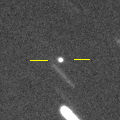
|
Now it is 16.0 mag (Feb. 7, Toshihiko Ikemura, Hirohisa Sato). It will be fading after this, and will be fainter than 18 mag in April. In the Northern Hemisphere, it stays observable in good condition for a long time after this. In the Southern Hemisphere, it will never be unobservable after this.
Date(TT) R.A. (2000) Decl. Delta r Elong. m1 Best Time(A, h)
Feb. 20 1 58.55 34 55.3 1.554 1.535 70 17.1 20:17 (132, -3)
Feb. 27 2 21.10 37 21.6 1.632 1.577 69 17.2 20:07 (135, -3)
|

|
Now it is 17.7 mag (Sept. 14, Slooh.com Chile Observatory, La Dehesa). It will brighten up to 16.5 mag in summer.
Date(TT) R.A. (2000) Decl. Delta r Elong. m1 Best Time(A, h)
Feb. 20 17 26.77 -35 30.8 5.357 5.082 68 17.2 4:08 (286, 50)
Feb. 27 17 30.27 -35 2.4 5.234 5.066 74 17.1 4:17 (282, 56)
|
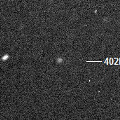
|
First return of a new periodic comet which brightened up to 16 mag from 2003 to 2004. Now it is 17.6 mag (Feb. 7, Toshihiko Ikemura, Hirohisa Sato). It will brighten up to 16 mag in next winter.
Date(TT) R.A. (2000) Decl. Delta r Elong. m1 Best Time(A, h)
Feb. 20 2 49.99 -12 53.5 4.561 4.281 67 17.2 20:17 (102, 38)
Feb. 27 2 54.83 -11 46.7 4.628 4.266 62 17.2 20:07 (101, 35)
|

|
Now it is 18.2 mag (Feb. 2, Thomas Lehmann). It is expected to brighten up to 12 mag in 2022. In the Southern Hemisphere, it stays observable in good condition for a long time. In the Northern Hemisphere, it locates extremely low until mid February, then it becomes unobservable until 2022.
Date(TT) R.A. (2000) Decl. Delta r Elong. m1 Best Time(A, h)
Feb. 20 2 41.86 -45 43.1 6.355 6.025 66 17.3 20:17 ( 58, 48)
Feb. 27 2 41.97 -45 4.7 6.353 5.976 63 17.3 20:07 ( 59, 45)
|

|
Now it is 17.3 mag (Feb. 8, Toshihiko Ikemura, Hirohisa Sato). Although it is an asteroid, it is brightening rapidly. It may brighten up to 11 mag in 2023. In the Northern Hemisphere, it stays observable in good condition for a long time. In the Southern Hemisphere, it is not observable now. It will appear in mid March, but it stays extremely low after that.
Date(TT) R.A. (2000) Decl. Delta r Elong. m1 Best Time(A, h)
Feb. 20 18 34.60 39 23.2 7.580 7.327 71 17.4 4:08 (226, -7)
Feb. 27 18 35.75 40 4.8 7.489 7.282 74 17.3 4:17 (220, -2)
|
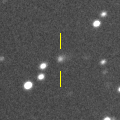
|
It brightened up to 16.1 mag in last winter (Mar. 18, Toshihiko Ikemura, Hirohisa Sato). Now it is 17.6 mag (Feb. 9, Toshihiko Ikemura, Hirohisa Sato). In 2021, it stays observable at 17-18 mag in good condition until early summer.
Date(TT) R.A. (2000) Decl. Delta r Elong. m1 Best Time(A, h)
Feb. 20 13 14.48 -20 2.3 6.235 6.859 125 17.5 3:15 (180, 75)
Feb. 27 13 13.78 -19 46.5 6.161 6.872 132 17.5 2:47 (180, 75)
|
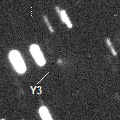
|
Now it is 17.0 mag (Feb. 15, Michael Jager). It stays 17.5 mag and observable in good condition until March.
Date(TT) R.A. (2000) Decl. Delta r Elong. m1 Best Time(A, h)
Feb. 20 14 58.80 8 12.0 1.671 2.210 109 17.6 4:08 (198, 45)
Feb. 27 15 0.20 13 30.7 1.627 2.246 116 17.6 4:17 (185, 42)
|

|
Now it is 18.0 mag (Feb. 6, Toshihiko Ikemura, Hirohisa Sato). It stays 17-18 mag for a long time from 2021 to 2023.
Date(TT) R.A. (2000) Decl. Delta r Elong. m1 Best Time(A, h)
Feb. 20 11 0.71 10 41.0 3.983 4.956 168 17.6 1:02 (180, 44)
Feb. 27 10 57.31 11 0.2 3.961 4.948 174 17.6 0:31 (180, 44)
|
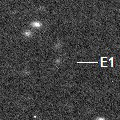
|
First return of a new periodic comet which brightened up to 16 mag in 2014. Now it is 18.3 mag (Feb. 14, Michael Jager). It will brighten up to 17 mag in spring, and it will be observable in good condition.
Date(TT) R.A. (2000) Decl. Delta r Elong. m1 Best Time(A, h)
Feb. 20 13 1.55 12 30.2 1.581 2.415 138 17.7 3:03 (180, 43)
Feb. 27 12 59.87 12 40.9 1.510 2.392 145 17.6 2:33 (180, 42)
|
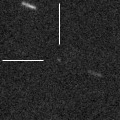
|
Now it is 17.0 mag (Feb. 7, Toshihiko Ikemura, Hirohisa Sato). Although it is an asteroid, it is brightening rapidly. It stays 17-18 mag for a long time from 2021 to 2022. In the Southern Hemisphere, it stays observable in good condition for a long time. In the Northern Hemisphere, it is observable only until May.
Date(TT) R.A. (2000) Decl. Delta r Elong. m1 Best Time(A, h)
Feb. 20 8 54.71 -6 22.0 4.781 5.685 153 17.7 22:52 (180, 61)
Feb. 27 8 48.23 -6 34.3 4.800 5.667 148 17.7 22:18 (180, 62)
|
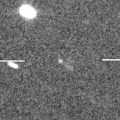
|
Now it is 17.2 mag (Feb. 8, Toshihiko Ikemura, Hirohisa Sato). It is expected to brighten up to 10 mag in 2023. In the Northern Hemisphere, it stays observable in good condition until 2023 autumn. In the Southern Hemipshere, it stays extremely low until mid July, then it becomes unobservable for a while. But it becomes observable in good condition after 2023 summer.
Date(TT) R.A. (2000) Decl. Delta r Elong. m1 Best Time(A, h)
Feb. 20 13 11.45 32 34.7 7.197 7.914 133 17.8 3:12 (180, 23)
Feb. 27 13 8.11 33 28.7 7.102 7.863 137 17.7 2:42 (180, 22)
|

|
It stays 17-18 mag for a long time until 2026. In the Southern Hemisphere, it stays sobservable in good condition for a long time. It is not observable in the Northern Hemisphere.
Date(TT) R.A. (2000) Decl. Delta r Elong. m1 Best Time(A, h)
Feb. 20 9 23.58 -57 23.7 11.203 11.591 110 17.9 23:20 ( 0, 68)
Feb. 27 9 18.41 -57 23.3 11.166 11.575 112 17.9 22:48 ( 0, 68)
|
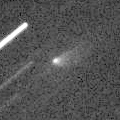
|
First return of a new periodic comet which brightened up to 17 mag in 2013. Now it is 18.0 mag (Feb. 9, Toshihiko Ikemura, Hirohisa Sato). It will be fainter than 18 mag in late February.
Date(TT) R.A. (2000) Decl. Delta r Elong. m1 Best Time(A, h)
Feb. 20 13 51.37 -5 37.5 0.530 1.354 123 17.9 3:52 (180, 61)
Feb. 27 13 46.89 -7 19.7 0.541 1.404 130 18.1 3:20 (180, 62)
|

|
Five apparitions of this comet was confirmed in 1999, 2004, 2008, 2012 and 2016. It approached to Sun down to 0.04 a.u. on Jan. 17. It may be observed on the ground in December and February.
Date(TT) R.A. (2000) Decl. Delta r Elong. m1 Best Time(A, h)
Feb. 20 3 3.52 21 0.3 0.595 1.044 78 19.1 20:17 (134, 18)
Feb. 27 3 59.41 23 37.3 0.755 1.183 84 20.1 20:07 (142, 21)
|
|
![]()
 C/2020 R4 ( ATLAS )
C/2020 R4 ( ATLAS ) C/2021 A2 ( NEOWISE )
C/2021 A2 ( NEOWISE ) 10P/Tempel 2
10P/Tempel 2 C/2019 N1 ( ATLAS )
C/2019 N1 ( ATLAS ) C/2020 S3 ( Erasmus )
C/2020 S3 ( Erasmus ) 156P/Russell-LINEAR
156P/Russell-LINEAR C/2019 L3 ( ATLAS )
C/2019 L3 ( ATLAS ) 88P/Howell
88P/Howell C/2020 M3 ( ATLAS )
C/2020 M3 ( ATLAS ) C/2021 A4 ( NEOWISE )
C/2021 A4 ( NEOWISE ) 29P/Schwassmann-Wachmann 1
29P/Schwassmann-Wachmann 1 C/2019 F1 ( ATLAS-Africano )
C/2019 F1 ( ATLAS-Africano ) C/2017 K2 ( PanSTARRS )
C/2017 K2 ( PanSTARRS ) 246P/NEAT
246P/NEAT C/2020 T2 ( Palomar )
C/2020 T2 ( Palomar ) 398P/2020 P2 ( Boattini )
398P/2020 P2 ( Boattini ) 141P/Machholz 2
141P/Machholz 2 C/2020 J1 ( SONEAR )
C/2020 J1 ( SONEAR ) 414P/2021 A3 ( STEREO )
414P/2021 A3 ( STEREO ) C/2019 T4 ( ATLAS )
C/2019 T4 ( ATLAS ) C/2018 U1 ( Lemmon )
C/2018 U1 ( Lemmon ) C/2017 T2 ( PanSTARRS )
C/2017 T2 ( PanSTARRS ) 17P/Holmes
17P/Holmes P/2020 U2 ( PanSTARRS )
P/2020 U2 ( PanSTARRS ) C/2020 F5 ( MASTER )
C/2020 F5 ( MASTER ) C/2020 N1 ( PanSTARRS )
C/2020 N1 ( PanSTARRS ) 409P/2020 V1 ( LONEOS-Hill )
409P/2020 V1 ( LONEOS-Hill ) C/2019 T2 ( Lemmon )
C/2019 T2 ( Lemmon ) C/2019 K7 ( Smith )
C/2019 K7 ( Smith ) C/2020 K5 ( PanSTARRS )
C/2020 K5 ( PanSTARRS ) 28P/Neujmin 1
28P/Neujmin 1 7P/Pons-Winnecke
7P/Pons-Winnecke 117P/Helin-Roman-Alu 1
117P/Helin-Roman-Alu 1 C/2018 N2 ( ASASSN )
C/2018 N2 ( ASASSN ) C/2021 A7 ( NEOWISE )
C/2021 A7 ( NEOWISE ) C/2020 M5 ( ATLAS )
C/2020 M5 ( ATLAS ) P/2020 T3 ( PanSTARRS )
P/2020 T3 ( PanSTARRS ) 277P/LINEAR
277P/LINEAR C/2020 Y2 ( ATLAS )
C/2020 Y2 ( ATLAS ) C/2017 Y2 ( PanSTARRS )
C/2017 Y2 ( PanSTARRS ) C/2019 O3 ( Palomar )
C/2019 O3 ( Palomar ) C/2020 H6 ( ATLAS )
C/2020 H6 ( ATLAS ) C/2017 U7 ( PanSTARRS )
C/2017 U7 ( PanSTARRS ) 162P/Siding Spring
162P/Siding Spring C/2020 O2 ( Amaral )
C/2020 O2 ( Amaral ) 402P/2020 Q3 ( LINEAR )
402P/2020 Q3 ( LINEAR ) C/2020 R7 ( ATLAS )
C/2020 R7 ( ATLAS ) A/2019 U5
A/2019 U5 C/2019 C1 ( ATLAS )
C/2019 C1 ( ATLAS ) C/2020 Y3 ( ATLAS )
C/2020 Y3 ( ATLAS ) 99P/Kowal 1
99P/Kowal 1 413P/2020 W4 ( Larson )
413P/2020 W4 ( Larson ) A/2020 F7
A/2020 F7 C/2020 V2 ( ZTF )
C/2020 V2 ( ZTF ) C/2019 E3 ( ATLAS )
C/2019 E3 ( ATLAS ) 405P/2020 U1 ( Lemmon )
405P/2020 U1 ( Lemmon ) 323P/SOHO
323P/SOHO![]()




















































